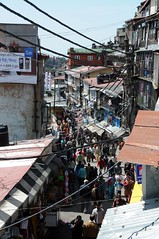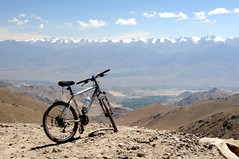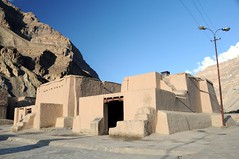Who would have that thought coming to Nepal we would end up on an elephant safari. Mountains and trekking are usually associated with this landlocked country stuck between the two giants of India and China. But a safari in the fabulous Chitwan National Park is how we have ended our visit here, and it could have topped the trekking as the highlight of the country or perhaps our entire travels so far.
It is not often that you get to see magestic One-Horned Indian Rhinos in the wild but this is surprisingly what we got to see. It was surprising because they (more amazingly there was not one but two together) were not bothered as we and about 10 other elephants loaded with tourists crashed our way through the forests in search of them. The mahoots shouting to each other did not disturb them either, as we finally came across the two grazing grey armoured endangered beasts as dusk approached.

Not so sneaking up to a Rhino
It was a special end to a fantastic day which started bright and early with a trip downriver in a dug-out canoe, spotting the snout of a fresh-water crocodile, and then a two-hour hike through the jungle forests. We had the usual danger speech beforehand - this is what you do if we get charged by a rhino, if a Bengal tiger attacks do this and if a wild elephant decides to go for us then we are done for. Unfortunately we didn't encounter any of that; we spotted some deer and - for the first time away from their scavenging role at temples - monkeys in their natural habitat.
But Chitwan has only been the climax of what has been an excellent three weeks here. We flew from Delhi to Kathmandu and were greeted by the familiar face of my mother amongst the crowds outside the airport. She had arrived earlier and was to be our first travel companion from home on our trip.
Kathmandu was seen from the blissful environs of Boudnath, the location for a massive stupa (Buddhist spire) where devout Tibetans lap clockwise. From our base we explored the area and visited the medieval suburb of Patan south of the river. The small narrow streets were packed with tight-knit Hindu shrines and temples, culminating in the large Durbar square. Multi-tiered distinctive Newari temples were architecturally amazing and again another stereotype of Nepal was shattered – more than just a mountain range for trekking in.
We ventured into the touristy suburb of Thamel for a night to be close to the bus stop to get to Pokhara. The peace we were accustomed to in Boudnath was broken by the neon lights, touts, feral street kids fighting and general overload of population density. It was good to get away in the end and head west, in search of the stereotyipcal image of Nepal: mountains.
Pokhara delivered. Initially everything was clouded but in the afternoon the heavens opened and there in front of us were the famous Annapurnas gleaming bright white and rearing above us. Massive mountains know how to make you feel small and these did. No matter how many times you view them you never get sick of their sight. They are glorious reminders of nature's beauty. Photos of course can never do it justice, but it doesn't stop you trying.
Pokhara though is a tourist town, and had all the trappings that that involves. Despite this, there can't be too many towns in the world where you can sip your latte as you gaze up on 7000m high mountains. The tourist area is well situated on the serene Fewa Tal lake and to kill time we hired a local woman to row us around as the sun set.
A trek into the Annapurna region is a must if you come to Pokhara. A complete circuit of the range would take almost three weeks and was beyond our time scope or our fitness level. We instead decided to do a five day trek to a popular 3200m high spot called Poon Hill where the Annapurnas and the nearby Dhaulagiri, seventh highest mountain in the world, are viewed in all their glory.

Dawn at Poon Hill
To gear up for it and to make sure our fitness was up to scratch we tackled another viewing hill closer to Pokhara called Sarangkot. The views are usually superb, at the right time of year, but as we are only now just starting to depart the monsoon for the dryer seasons, the clouds decided to block any view after our hard climb up 800m all the way from town. We stayed the night there but the view in the morning – usually the best time - wasn't any better.
Our trek to Poon Hill was delayed as a rest day was imposed on us by the monsoon. On our day of departure the rain sheeted down and filled the streets, turning the one outside our guesthouse into a river. It stopped our activities but fortunately it seemed like the last gasp of a dying beast, and the next day we departed via taxi out to the start of the trek.
Trekking in Nepal is unlike trekking anywhere else in the world. The paths along the popular routes are nicely paved, you share the route with pack horses, goats heading to market and locals heading home. Then there is the famous scenery, often just as impressive as the mountains: green forested slopes worked with rice paddy terraces. The scenery changes depending on where you are and on the entire Annapurna circuit it turns more into Tibetan style rocky environment north of the range.
On the third morning we clambered up in the half light of dawn to the top of Poon Hill. The views were literally breathtaking as we recovered from the exertion of getting to the top. Luck was finally with us and we were treated to a perfect clear dawn with sun rising behind the Annapurna range to the east and Dhaulagiri lit up to the north. It was a special moment for all of us.
Trekking is an industry here and so almost everything is geared towards it. There are lodges everywhere, all with attached restaurants providing all the usual travellers' fare. Facilities range from the more basic, rough timber floors with squat toilets, to sophisticated ones with flushing toilets and hot and cold showers.
Unfortunately in some parts a culture seems to have developed of milking tourists for all they're worth. Cartels, or as they are called here "Committees or Associations", set menu prices for all the lodges on the trails across a certain area. They set their prices at two or usually three times the prices of what the same meal costs back in town.
I understand that there is a higher cost associated with carting goods to the lodges by porters but when the item you want to eat – a locally grown meal that locals eat - is ludicrously expensive, you have to wonder. And strangely with the portering costs a beer is not that much more expensive than in town.
But that's enough of my rant. We immeasurably enjoyed our hike, and I am extremely proud of mum carrying her pack (almost) the whole way, when virtually everybody else was using porters. We have now made our way down to the tropical plains and the animal spotting. And in amongst this I got to spend another birthday in another country and what a special one it was.



